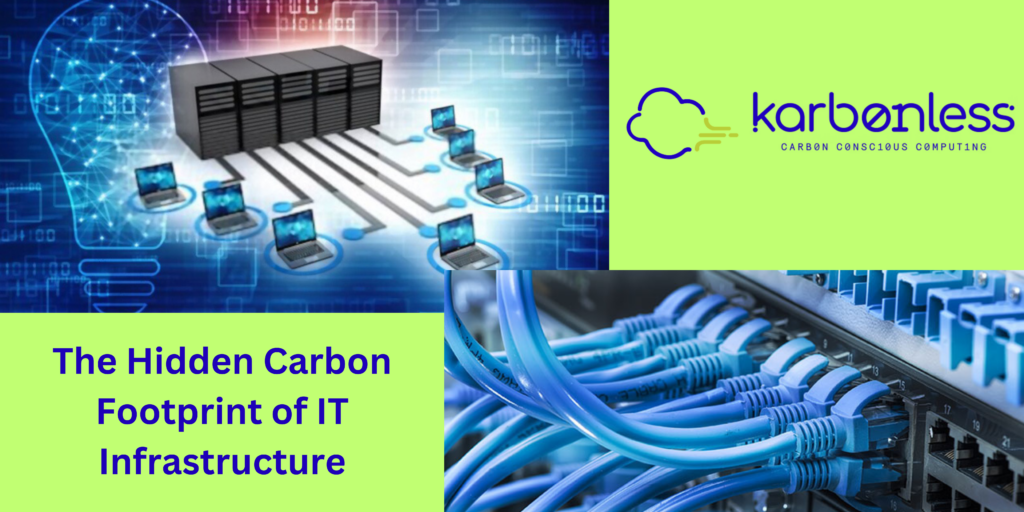
As the Director of Karbonless.ai, I frequently encounter a common misconception: that service companies, being less industrial in nature, have minimal environmental impact. However, the reality is more complex – especially when we consider the massive carbon footprint of our digital operations.
The Digital Elephant in the Room: Impact of IT Infrastructure & Data Center Operations
The foundation of modern service companies rests on data centers, which account for approximately 3-4% of global electricity consumption. Particularly, in Service economies in markets like Singapore, the percentage rises to a more alarming 6-7%. Most data centers operate at a significantly efficient Power Usage Effectiveness of 1.3, which means that IT Infrastructure take up 65-70+% of the power that is pumped into the DC. This includes IT devices and server farms, redundancy systems, network equipment and & backup power.
Cloud Computing’s Environmental Cost
While cloud migration often appears eco-friendly, it’s crucial to understand its environmental impact. Each cloud storage terabyte can generate up to 3,000 kg of CO2 annually. In addition, virtual machines running continuously, data replications for reliability and even edge computing nodes required to ensure speedy responses to customers, all contribute to baseline energy consumption and consequent GHG emissions.
From an end-user computing standpoint, the IT infrastructure includes workstations, laptops, mobile devices and tablets, printing and scanning infrastructure, and even the network equipment to maintain operational connectivity.

Beyond Hardware- Software’s hidden Impact and Shared facilities
An often-overlooked aspect is how software efficiency affects carbon footprint.
- Poorly optimized applications requiring more processing power
- Advent and explosive growth of specialized processing units- GPUs, TPUs and other xPUs that require a lot of computing capabilities and drive heavy power consumption.
- Redundant data storage and unnecessary backups
- Resource-intensive, and “easy” provisioning of new development and testing environments, leading to “wasteful consumption”
- Continuous Integration/ Continuous Deployment (CI/CD) pipelines running 24/7, driving high cost of operations even in dev-test environments.
- Email systems (a single email with a large attachment can generate up to 50 grams of CO2)
- Video conferencing services consuming bandwidth and processing power
- Collaborative tools and platforms running continuously
- Digital storage growing exponentially year over year
Strategic Solutions for IT Sustainability- Some immediate action recommendations
You cannot manage what you cannot measure. So, the first step to sustainability solutioning is to get a clear measure of the Carbon footprint of both the IT and the non-IT infrastructure. The more granular the data, the better it is for identifying the hotspots to monitor and manage. Management models can include any combination of the following:
1. Infrastructure Optimization
- Move to a cloud optimized environment from an on-premises deployment model. This allows organization to leverage the optimization techniques provides by CSPs and dynamically provision infrastructure, basis predictive need and demand.
- Work in partnership with cloud providers who use renewable energy.
- Implement server virtualization and auto-scaling to increase utilization
- Do a regular audit of zombie servers and unused resources. Use audit mechanisms also to leverage the latest optimized and sustainable equipment to maintain and enhance operational efficiencies.
2. Software Efficiency
- Code optimization- use of containers, serverless and stateless models for reduced processing requirements
- Use solutions from ISVs who are delivering optimized infrastructure offerings- minimizing “wasteful consumption”
- Implementation of efficient data storage strategies
- Regular cleanup of unnecessary data and applications
Why This Matters Now
The service sector represents over 65% of global GDP, with IT infrastructure being a critical emissions contributor. As regulations tighten and stakeholders demand greater environmental responsibility, understanding and managing your technology-related carbon footprint isn’t just environmentally conscious – it’s a business imperative. Regulatory bodies and Governments are beginning to ask for Carbon footprint data as part of the regular reporting and audits. At the same time, there are governments providing incentives to companies to invest in carbon reduction techniques, projects and deployments.
Scope 1 and Scope 2 emissions within Service organizations such as banks and Financial Institutions, Malls and Shopping centers, Government offices, schools, include other building facilities that cause significant carbon footprint. These include lighting systems, air conditioning equipment, elevators and escalators, fire systems, security and water systems etc. For specialized facilities like hospitals and hotels, there are other specialized equipment like stoves and ovens, MRI and diagnostic equipment, cooking ranges, grinding machines and so on. Of course, direct fuel burning for supply chain network, (including nodes and connectors), airports, aircrafts, railway networks and road transport vehicles and delivery services, transportation and travel, cargo equipment etc are additional elements for GHG emissions and carbon footprint.
Looking Ahead
The future of sustainable business practices in the service sector lies in the intersection of technology and environmental consciousness. By leveraging advanced monitoring and management tools, companies can transform their environmental impact from a challenge into a competitive advantage. With non-IT infrastructure, data points based on metering models will allow you to identify hotspots, key contributors, efficiency improvement models and others to continuously increase efficiency, throughput and reduce operational costs.
Would you like to learn more about how your service company can start its journey toward carbon consciousness, particularly in managing IT infrastructure emissions? Connect with me or visit Karbonless.ai to explore how we’re helping companies measure, monitor, and manage their carbon footprint effectively across all Scope 1 and Scope 2 emissions.
#Sustainability #CarbonFootprint #GreenIT #ServiceIndustry #ClimateAction #BusinessLeadership #TechSustainability #InfrastructureSustainability #ITInfrastructure #GHGEmissions #GHGProtocol
@karbonless.ai
Leave a Reply